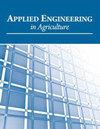Choice of Pipe Material Influences Drain Spacing and System Cost in Subsurface Drainage Design
IF 0.9
4区 农林科学
Q4 AGRICULTURAL ENGINEERING
引用次数: 6
Abstract
HighlightsFor 3- or 4-row regular-perforated pipes, the effective radius ranged from 0.3 to 0.9 cm (average 0.6 cm).For 8-row regular-perforated pipes, the effective radius was 1.9 cm.The effective radius of sock-wrapped pipes ranged from 5.7 to 6.0 cm (average 5.9 cm).The 8-row sand-slot pipes had a lower initial system cost than the sock-wrapped pipes.The 8-row regular-perforated pipes had a lower initial system cost than the 4-row regular-perforated pipes.Abstract. Knitted-sock envelopes are applied in agricultural subsurface drainage to prevent sediment clogging of the drain pipes. In the United States and Canada, sand-slot pipes are sometimes used as a cheaper alternative to sock-wrapped pipes. However, their initial system cost has not been compared. The main objective of this study was to evaluate the effect of pipe material on drain spacing and initial system cost. First, the theoretical effective radius of each pipe material was estimated. Then, the drain spacing was calculated for each pipe material in a drainage design, such that each pipe would provide the same design drainage rate (i.e., same water removal rate). The results showed that the effective radius of sock-wrapped pipes (average 5.9 cm) was much greater than that of 4-row (average 0.4 cm) and 8-row perforated sand-slot pipes (average 1.6 cm). Rows refer to number of longitudinal rows of perforations. The sock-wrapped pipes considerably increased the effective radius of the pipe by reducing the entrance head loss. Furthermore, the sock-wrapped pipes allowed for a wider drain spacing (ranging from 0.8 to 5.4 m wider) in soil with risk of drain sedimentation, thereby reducing the total length of the lateral drain pipe needed for drainage design compared to both 4- and 8-row sand-slot pipes. The 8-row regular-perforated pipes allowed for a wider optimum drain spacing, thereby reducing the initial system cost in soil without a drain sedimentation issue compared to 4-row regular-perforated pipes. In conclusion, even though the sock-wrapped pipe reduced the total length of the lateral drain pipe, the 8-row sand-slot pipe had a lower initial system cost compared to the sock-wrapped pipe, when designed at the same design drainage rate and drain depth. Keywords: Drain spacing, Effective radius, Entrance resistance, Geotextile, Knitted sock, Perforation.在地下排水设计中,管道材料的选择影响着排水间距和系统成本
对于3排或4排规则穿孔管,有效半径范围为0.3至0.9 cm(平均0.6 cm)。对于8排规则孔管,有效半径为1.9 cm。袜包管的有效半径为5.7 ~ 6.0 cm(平均5.9 cm)。与袜包管相比,8排砂槽管的初始系统成本更低。8排规则孔管比4排规则孔管具有更低的初始系统成本。针织袜围护结构应用于农业地下排水,以防止沉积物堵塞排水管。在美国和加拿大,沙槽管道有时被用作比袜子包裹管道更便宜的替代品。然而,它们的初始系统成本尚未进行比较。本研究的主要目的是评估管道材料对排水间距和初始系统成本的影响。首先,估算了各种管道材料的理论有效半径;然后,计算排水设计中每种管道材料的排水间距,使每根管道提供相同的设计排水速率(即相同的除水速率)。结果表明:袜包管的有效半径(平均5.9 cm)远大于4排(平均0.4 cm)和8排射孔沙槽管(平均1.6 cm);行指穿孔的纵向行数。袜包管通过减小入口水头损失,大大增加了管道的有效半径。此外,袜包管允许更宽的排水间距(从0.8到5.4米宽)在土壤中,有排水沉淀的风险,因此与4排和8排沙槽管相比,减少了排水设计所需的侧向排水管的总长度。与4排规则孔管相比,8排规则孔管允许更宽的最佳排水间距,从而降低了土壤中的初始系统成本,而且没有排水沉淀问题。综上所述,在设计排水速率和排水深度相同的情况下,尽管套筒缠绕管缩短了侧向排水管的总长度,但与套筒缠绕管相比,8排砂槽管的初始系统成本更低。关键词:排水间距,有效半径,入口阻力,土工布,针织袜,穿孔。
本文章由计算机程序翻译,如有差异,请以英文原文为准。
求助全文
约1分钟内获得全文
求助全文
来源期刊

Applied Engineering in Agriculture
农林科学-农业工程
CiteScore
1.80
自引率
11.10%
发文量
69
审稿时长
6 months
期刊介绍:
This peer-reviewed journal publishes applications of engineering and technology research that address agricultural, food, and biological systems problems. Submissions must include results of practical experiences, tests, or trials presented in a manner and style that will allow easy adaptation by others; results of reviews or studies of installations or applications with substantially new or significant information not readily available in other refereed publications; or a description of successful methods of techniques of education, outreach, or technology transfer.
 求助内容:
求助内容: 应助结果提醒方式:
应助结果提醒方式:


